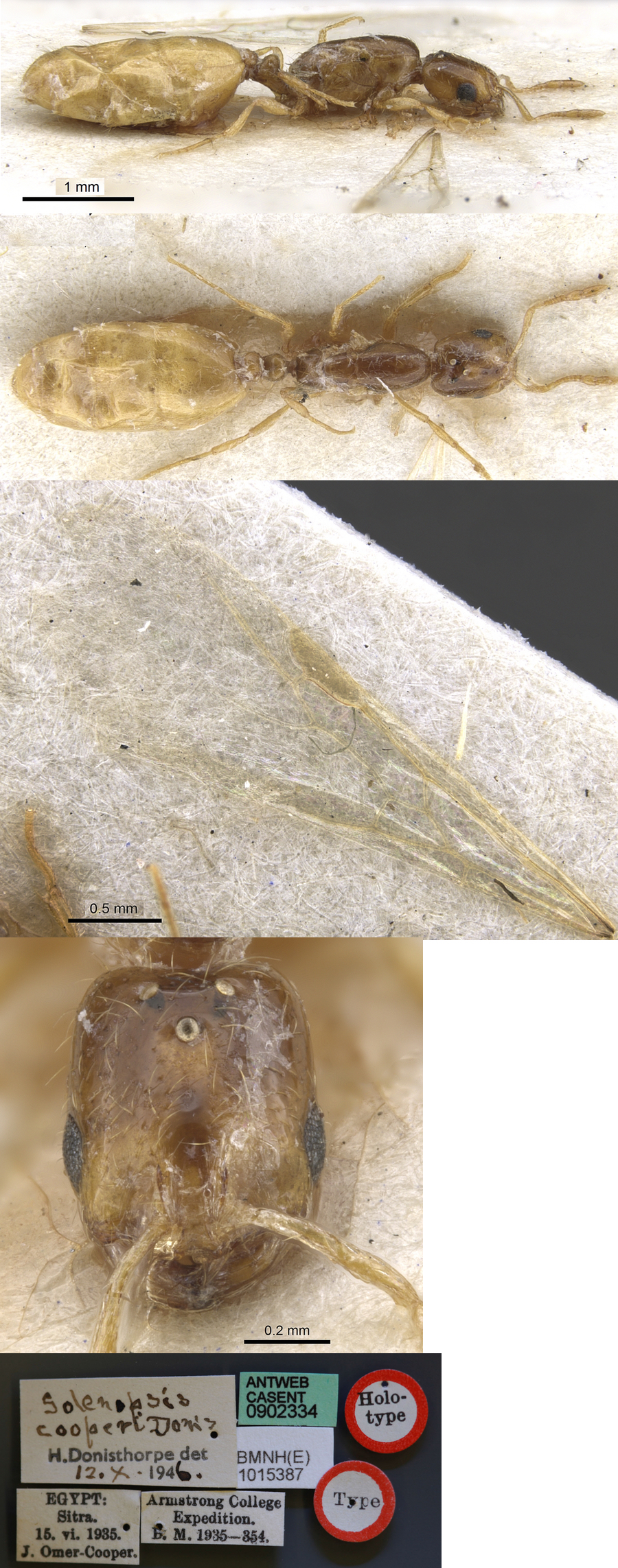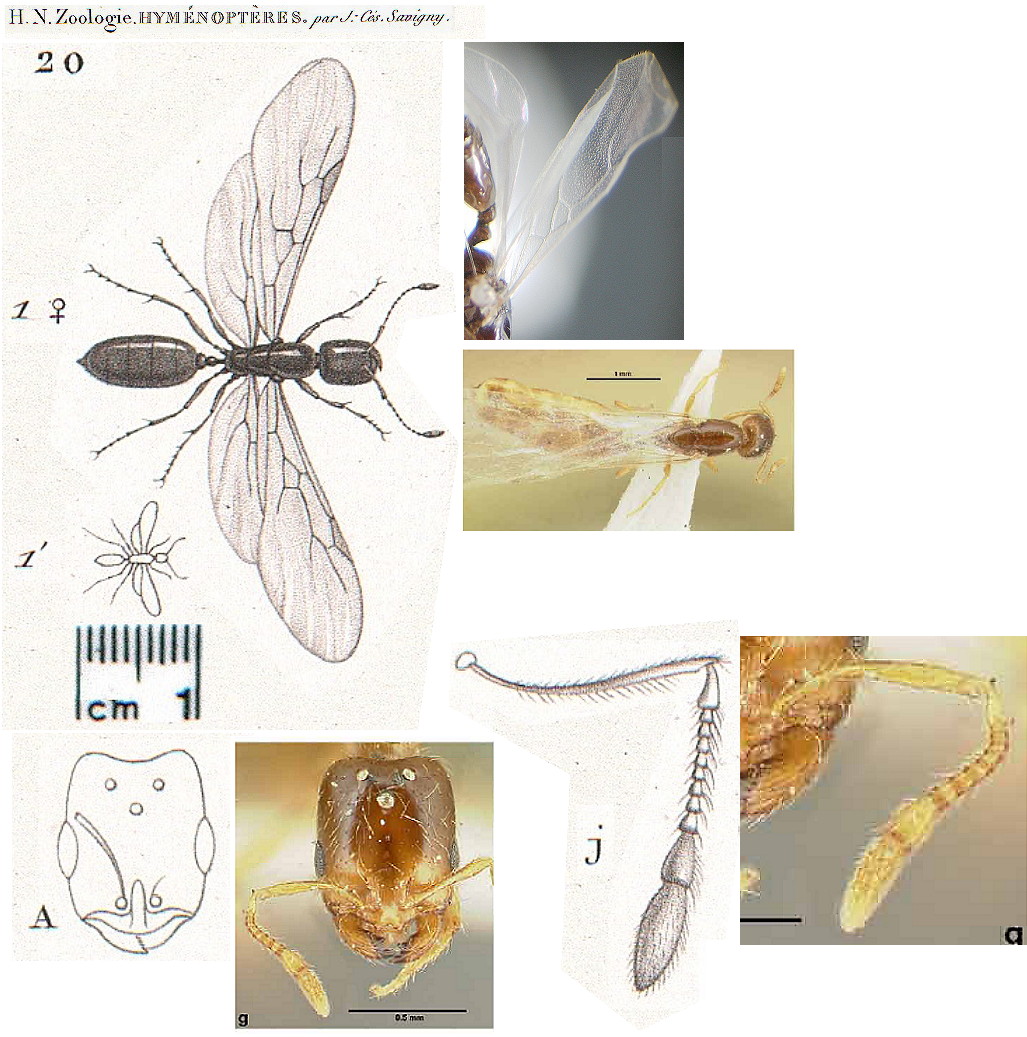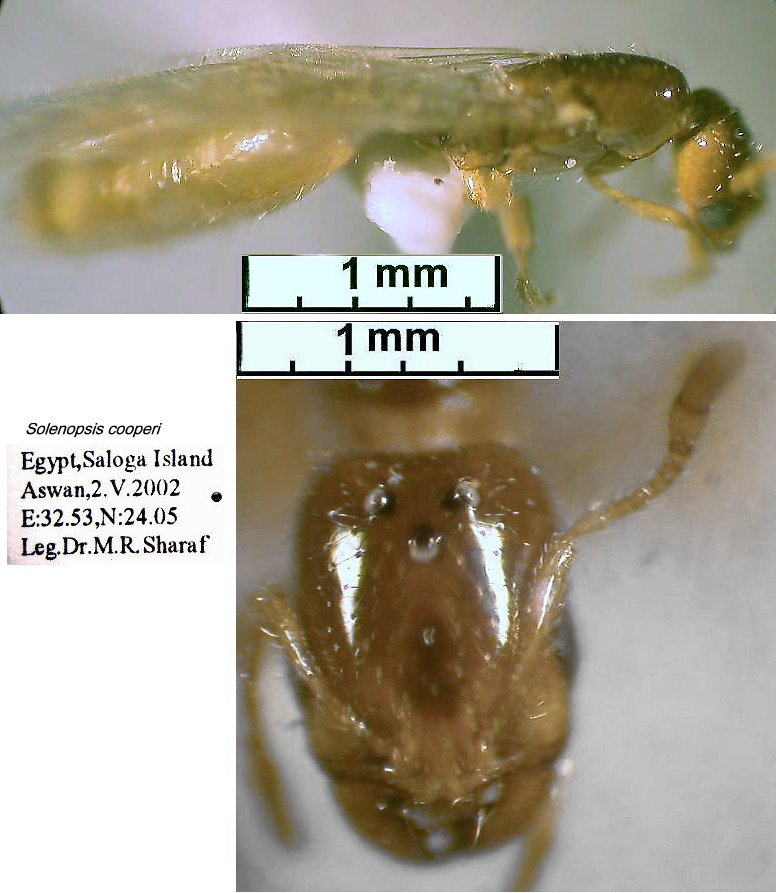Solenopsis cooperi Donisthorpe
  Type location Egypt
(Donisthorpe, 1947e: 110, male & queen). Type location Egypt
(Donisthorpe, 1947e: 110, male & queen).
|
Donisthorpe's (1947e) description is at  . .
Egypt records - 8 alate queens & 5 males;
collected by J Omer-Cooper; at Siwa, 15 & 24.v.1935; also 175 males
from Siwa, 21.viii.1935, reported earlier as unnamed by Donisthorpe
(1942a: 30). Sharaf list - material examined: Mafareq (South Sinai),
5.iii.1998 (11) (SHC).
Mohamad thesis (1979) had - Burg El-Arab (Alexandria),
20.iii.1956 (Coll.Alf.) Burg El-Arab (Alexandria), 20.iii.1956 (Coll.Ain.)
Ecological note (M Sharaf) - this species was observed
nesting under the base of a tree trunk under ground, in a sandy soil in
Saloga protected island, Aswan; there were a nest of a termite Ametermes
aswanensis close to the ant nest.
|
 The
photomontage of the type queen is collated from http://www.antweb.org/specimen.do?name=casent0902334 The
photomontage of the type queen is collated from http://www.antweb.org/specimen.do?name=casent0902334
|
 Possibly
the best candidate for the queen illustrated by Savigny (Audouin, J.-V.
1825-27: Plate 20 Fig 20). Possibly
the best candidate for the queen illustrated by Savigny (Audouin, J.-V.
1825-27: Plate 20 Fig 20).
|
Oxford University Museum
specimens
Solenopsis cooperi
B Taylor det.
|
Egypt
M Sharaf
|
2.v.2002
Aswan
24°05' N
32°56' E
|
Saloga Island
|
3
|
 |
|
 The
photomontage is of a queen, photographed by Mostafa Sharaf. After
colour correction, the appearance is a close match to the type queen
and the description
given by Donisthorpe (1942a); notably being
brown, with a yellow gaster, smooth & shining, with pale yellow
appendages. the large ocelli also appear to be very distinctive
compared to the other circum-Mediterranean species. The
photomontage is of a queen, photographed by Mostafa Sharaf. After
colour correction, the appearance is a close match to the type queen
and the description
given by Donisthorpe (1942a); notably being
brown, with a yellow gaster, smooth & shining, with pale yellow
appendages. the large ocelli also appear to be very distinctive
compared to the other circum-Mediterranean species.
|
 The
photomontage and the one below are of workers from
Saloga Island, Aswan, collected by Mostafa Sharaf, 2.v.2002, in
association with the male shown above. These are readily distinguished
from the known circum-Mediterranean species by the long pedicel to the
petiole; the relatively high, narrowly rounded petiole profile; the
longer head with a flat narrow profile; also the angular near dentate
and longitudinally weakly furrowed propodeum. The
photomontage and the one below are of workers from
Saloga Island, Aswan, collected by Mostafa Sharaf, 2.v.2002, in
association with the male shown above. These are readily distinguished
from the known circum-Mediterranean species by the long pedicel to the
petiole; the relatively high, narrowly rounded petiole profile; the
longer head with a flat narrow profile; also the angular near dentate
and longitudinally weakly furrowed propodeum.
|
 Second worker Second worker
|
 The photomontages are
of males from
Saloga Islands (Aswan), 2.v.2002, 24.05º N, 32.56 º E, collected by
Mostafa Sharaf, 2.v.2002. The photomontages are
of males from
Saloga Islands (Aswan), 2.v.2002, 24.05º N, 32.56 º E, collected by
Mostafa Sharaf, 2.v.2002.
These appear to match the rather short description of S.
cooperi given by Donisthorpe (1942a); notably being brown, smooth
& shining, with pale yellow appendages. the large ocelli also
appear to be very distinctive compared to the other
circum-Mediterranean species.
|
|